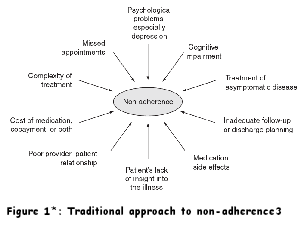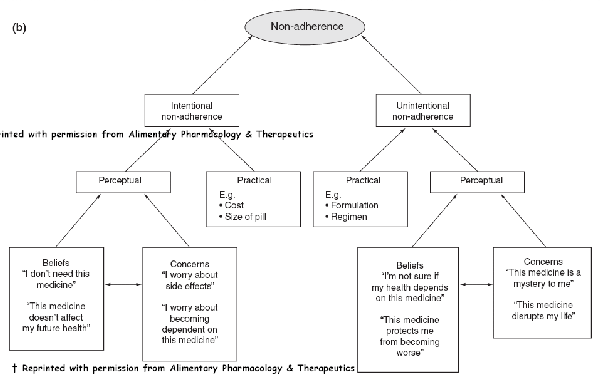Resolor – The importance of treatment adherence
This treatment adherence background information document has been prepared by Shire Pharmaceuticals and is for medical media only Non-adherence is a widespread, global problem in patients suffering from chronic diseases and in developed countries adherence averages only 50%.1
Adherence to treatment means much more than a patient taking his or her medication correctly. It represents a broad spectrum of behaviours ranging from the occasional missed dose, to a patient’s complete avoidance of their therapy.2
The use of the term compliance has been now largely superseded by the use of the term adherence, to highlight that the patient is an ‘active’ rather than ‘passive’ participant in the management of their disease.2 Concordance, a term used predominantly in the UK, is used to describe the two-way consultation process in which doctor and patient work together to reach agreement on therapeutic decisions.2
Traditional vs emerging concepts for identifying non-adherent patients
 Approaches to identify non-adherent patients (Figure 1) have traditionally been based on evaluating a variety of risk factors.3 Leading experts now propose an alternative concept based on patient-specific characteristics to address the particular reason behind an individual’s non-adherence (Figure 2).3 Using this new theory, non-adherent patients can be categorised broadly into intentional and unintentional non-adherers.
Approaches to identify non-adherent patients (Figure 1) have traditionally been based on evaluating a variety of risk factors.3 Leading experts now propose an alternative concept based on patient-specific characteristics to address the particular reason behind an individual’s non-adherence (Figure 2).3 Using this new theory, non-adherent patients can be categorised broadly into intentional and unintentional non-adherers.
- Unintentional non-adherence is driven by factors outside of the patient’s control, such as forgetfulness, poor comprehension of the drug regimen, language barriers or difficulty administering the medication2
- Intentional non-adherent patients make a conscious decision not to take their medication2
These behaviours are made up of practical barriers and perceptual barriers. Practical barriers include issues such as the cost of medication, the size of the pill and the route of administration. Perceptual barriers are dependent on personal beliefs and concerns.
Figure 2†: Emerging concept of non-adherence3

Importance of treatment adherence in chronic diseases
Non-adherence has both a clinical and economic impact for chronic disorders. For example, in a chronic disorder such as ulcerative colitis, non-adherent patients can be five times more likely to relapse than adherent patients.4
In general, non-adherence to treatment is also associated with higher healthcare costs, as patients may require in-patient services, the costs of which significantly outweigh the costs of the medication.5
Interventions for enhancing medication adherence have improved treatment outcomes in several chronic diseases including hyperlipidaemia and coronary artery disease,6 asthma,7 hypertension8 and diabetes.9 Moreover, strategies for improving treatment adherence in patients with a chronic disease such as asthma, not only improved symptom relief but decreased the number of days off work and the number of consultations with healthcare professionals.7 This suggests that increasing adherence rates is an important factor in the health status and quality of life of patients.1
Improving treatment adherence rates
The quality of the relationship between the doctor and the patient is an important consideration in treatment adherence.1 During consultation, alternative therapeutic strategies should be explored, adherence to treatment should be discussed and a follow-up plan developed.1 However, as no single strategy is effective across all patients, they must be tailored to the individual needs of the patient.1 For this to happen, healthcare professionals require tools to help identify and manage potential non-adherent patients, based on the patient’s attitudes and beliefs.1
Interventions such as improving information available to patients, simplified dosing and involving patients more in their care through self monitoring, have been employed as strategies to help increase adherence to long-term medication.1 Any such approach is dependent on the patient adapting their perceptions, which may be helped by proactively involving their families, carers and wider community.1 Also, there is evidence to suggest that peer support among patients can increase adherence to treatment, while decreasing the amount of time healthcare professionals devote to the care of chronic conditions.1
References
1 World Health Organization. Adherence to long-term therapies: evidence for action. 2003.
2 Horne R. Compliance, Adherence, and Concordance. Chest 2006; 130: 65S–72S.
3 Kane SV. & Robinson A. Review article: understanding adherence to medication in ulcerative colitis – innovative thinking and evolving concepts. Aliment Pharmacol Ther 2010; 32:1051–1058.
4 Kane S, Huo D, Aikens J, et al. Medication nonadherence and the outcomes of patients with quiescent ulcerative colitis. Am J Med 2003; 114: 39–43.
5 Kane S and Shaya F. Medication non-adherence is associated with increased medical health care costs. Dig Dis Sci 2008; 53: 1020–4.
6 Brown BG, Bardsley J, Poulin D, et al. Moderate dose, three-drug therapy with niacin, lovastatin, and colestipol to reduce low-density lipoprotein cholesterol <100 mg/dl in patients with hyperlipidemia and coronary artery disease. Am J Cardiol 1997; 80: 111–5.
7 Levy ML, Robb M, Allen J, et al. A randomized controlled evaluation of specialist nurse education following accident and emergency department attendance for acute asthma. Respiratory Medicine 2000; 94: 900–8.
8 Márquez Contreras E, Vegazo García O, Claros NM, et al. Efficacy of telephone and mail intervention in patient compliance with antihypertensive drugs in hypertension: ETECUM-HTA Study. Blood Pressure 2005; 14: 151–8.
9 Piette JD, Weinberger M, McPhee SJ, et al. Do automated calls with nurse follow-up improve selfcare and glycemic control among vulnerable patients with diabetes? Am J Med 2000; 108: 20–7.

